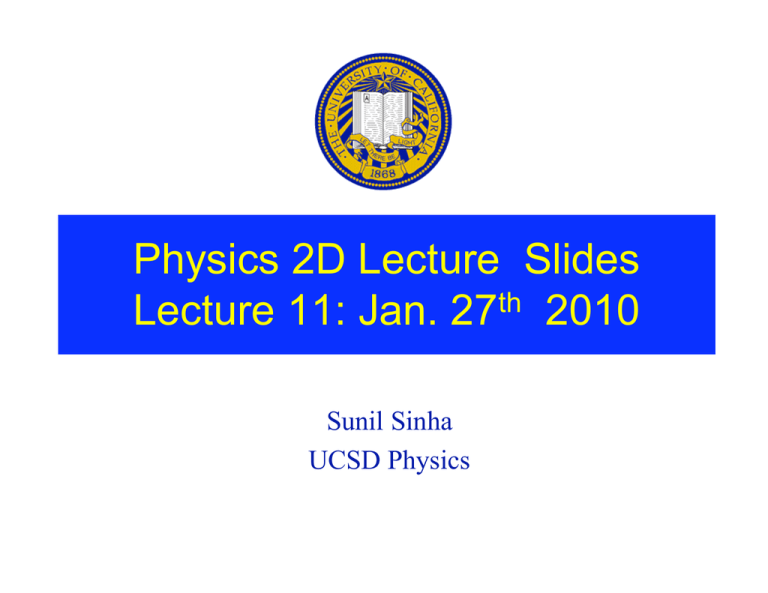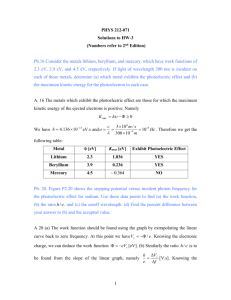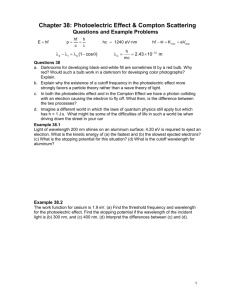Physics 2D Lecture Slides Lecture 11: Jan. 27 2010 th
advertisement

Physics 2D Lecture Slides Lecture 11: Jan. 27th 2010 Sunil Sinha UCSD Physics Einstein’s Explanation of PhotoElectric Effect What Maxwell Saw of EM Waves What Einstein Saw of EM Waves Light as bullets of “photons” Energy concentrated in photons Energy exchanged instantly Energy of EM Wave E= hf Einstein’s Explanation of Photoelectric Effect • Energy associated with EM waves in not uniformly distributed over wave-front, rather is contained in packets of “stuff”⇒ PHOTON • E= hf = hc/λ [ but is it the same h as in Planck’s th.?] • Light shining on metal emitter/cathode is a stream of photons of energy which depends on frequency f • Photons knock off electron from metal instantaneously – Transfer all energy to electron – Energy gets used up to pay for Work Function Φ (Binding Energy) • Rest of the energy shows up as KE of electron KE = hf- Φ • Cutoff Frequency hf0 = Φ (pops an electron, KE = 0) • Larger intensity I more photons incident • Low frequency light f not energetic enough to overcome work function of electron in atom Photo Electric & Einstein (Nobel Prize 1915) Light shining on metal cathode is made of photons Energy E, depends on frequency f , E = hf = h (c/λ) This QUANTUM of energy is used to knock off electron E = hf = ! + KEelectron eVs = KE = hf " ! I3 = 3I1 I2 = 2I1 I1= intensity -VS Photo Electric & Einstein (Nobel Prize 1915) Light shining on metal cathode is made of photons Quantum of Energy E = hf = KE + ϕ ⇒ KE = hf - ϕ Shining Light With Constant Intensity f1 > f2 >f3 f1 f2 f3 Modern View of Photoelectric Effect Is “h” same in Photoelectric Effect as BB Radiation? Slope h = 6.626 x 10-34 JS Einstein Nobel Prize! No matter where you travel in the galaxy and beyond… ..no matter what experiment You do h : Planck’s constant is same NOBEL PRIZE FOR PLANCK Work Function (Binding Energy) In Metals Photoelectric Effect on An Iron Surface: Light of Intensity I = 1.0 µ W/cm 2 incident on 1.0cm 2 surface of Fe Assume Fe reflects 96% of light further only 3% of incident light is Violet region (! = 250nm) barely above threshold frequency for Ph. El effect (a) Intensity available for Ph. El effect I =3% " 4% " (1.0 µ W/cm 2 ) (b) how many photo-electrons emitted per second ? Power 3% " 4% " (1.0 µ W/cm 2 ) ! # of photoelectrons = = hf hc (250 " 10#9 m)(1.2 " 10#9 J / s ) = 8 #34 (6.6 " 10 J i s )(3.0 " 10 m / s ) = 1.5 " 109 (c) Current in Ammeter : i = (1.6 " 10-19C )(1.5 " 109 ) = 2.4 " 10#10 A (d) Work Function $ = hf 0 = (4.14 " 10-15eV i s )(1.1" 1015 s #1 ) = 4.5 eV Facts • The human eye is a sensitive photon detector at visible wavelenghts: Need >5 photons of ≅ 550nm to register on your optical sensor • The Photographic process : – Energy to Dissociate an AgBr molecule = 0.6eV • Photosynthesis Process : 9 sunlight photon per reaction cycle of converting CO2 and water to carbohydrate & O2 – chlorophyll absorbs best at λ ≅ 650-700 nm • Designing Space Shuttle “skin” : Why Platinum is a good thing • designing Solar cells : picking your metal cathode Photon & Relativity: Wave or a Particle ? • • • • • Photon associated with EM waves, travel with speed =c For light (m =0) : Relativity says E2 = (pc)2 + (mc2)2 ⇒E = pc But Planck tells us : E = hf = h (c/λ) Put them together : hc /λ = pc – ⇒ p = h/λ – Momentum of the photon (light) is inversely proportional to λ • But we associate λ with waves & p with particles ….what is going on?? – A new paradigm of conversation with the subatomic particles : Quantum Physics X Rays “Bremsstrahlung”: The Braking Radiation • • • • EM radiation, produced by bombarding a metal target with energetic electrons. Produced in general by ALL decelerating charged particles X rays : very short λ ≅ 60-100 pm (10-12m), large frequency f Very penetrating because very energetic E = hf !! Useful for probing structure of sub-atomic Particles (and your teeth) X Ray Production Mechanism when electron passes near a positively charged target nucleus contained in target material, its deflected from its path because of its electrical attraction , experiences acceleration. Rules of E&M say that any charged particle will emit radiation when accelerated. This EM radiation “appears” as photons. Since photo carries energy and momentum, the electron must lose same amount. If all of electron’s energy is lost in just one single collision then hc hc e "V = hf max = or !min = !min e "V X Ray Spectrum in Molybdenum (Mo) • • • • • Braking radiation predicted by Maxwell’s eqn decelerated charged particle will radiate continuously Spikes in the spectrum are characteristic of the nuclear structure of target material and varies between materials Shown here are the α and β lines for Molybdenum (Mo) To measure the wavelength, diffraction grating is too wide, need smaller slits •An atomic crystal lattice as diffraction grating (Bragg) • X rays are EM waves of low wavelength, high frequency (and energy) and demonstrate characteristic features of a wave – Interference – Diffraction • To probe into a structure you need a light source with wavelength much smaller than the features of the object being probed – Good Resolution λ<< Δ • X rays allows one probe at atomic size (10-10)m Compton Scattering : Quantum Pool ! • 1922: Arthur Compton (USA) proves that X-rays (EM Waves) have particle like properties (acts like photons) – Showed that classical theory failed to explain the scattering effect of • X rays on to free (not bound, barely bound electrons) • Experiment : shine X ray EM waves on to a surface with “almost” free electrons – Watch the scattering of light off electron : measure time + wavelength of scattered X-ray Compton Effect: what should Happen Classically? • Plane wave [f,λ] incident on a surface with loosely bound electrons interaction of E field of EM wave with electron: F = eE • Electron oscillates with f = fincident • Eventually radiates spherical waves with fradiated= fincident – At all scattering angles, Δf & Δλ must be zero • Time delay while the electron gets a “tan” : soaks in radiation Compton Scattering : Setup & Results #! = (! '$ ! ) % (1 $ cos " ) Scattered ! ' larger than incident Compton Scattering Observations Compton Scattering : Summary of Observations #! = (! -! ) $ (1 % cos " ) ! Not isotropy in distribution of ' scattered radiation How does one explain this startling anisotropy? Compton Effect : Quantum (Relativistic) Pool Compton Scattering: Quantum Picture Energy Conservation: E+m e c = E '+ Ee 2 Momentum Conserv: p = p'cos! +p e cos " 0 = p'sin! -p e sin " Use these to eliminate electron deflection angle (not measured) p e cos ! = p # p 'cos " p e sin ! = p 'sin " Square and add $ p e2 = p 2 # 2 pp 'cos " + p '2 Eliminate p e & Ee using E e2 = pe2 c 2 + me2 c 4 & E e = ( E # E ') + me c 2 Compton Scattering: The Quantum Picture Energy Conservation: E+m e c 2 = E '+ Ee Momentum Conserv: p = p'cos! +p e cos " 0 = p'sin! -p e sin " Use these to eliminate ( (E ! E ') + me c 2 ) 2 = #$ p 2 ! 2 pp 'cos" + p '2 %& c 2 + (me c 2 )2 E For light p= ' c # E2 EE ' E '2 % 2 E + E ' ! 2EE '+ 2(E ! E ')me c = ( 2 ! 2 2 cos" + 2 ) c c c & $c ' ! EE '+ (E ! E ')me c 2 = ! EE 'cos" 2 2 2 E-E' 1 h ' = (1 ! cos" ) ' ( * '! * ) = ( )(1 ! cos" ) 2 EE' me c me c electron deflection angle (not measured) Rules of Quantum Pool between Photon and Electron h (! '# ! ) = ( )(1 # cos " ) me c Checking for h in Compton Scattering Plot scattered photon data, calculate slope and measure “h” It’s the same value for h again !! c me Δλ / h = h t g n le e v a w n o t p m Co λC 1-cos ϑ h (! '# ! ) = ( )(1 # cos " ) me c Energy Quantization is a UNIVERSAL characteristic of energy transactions ! Interference of Waves: A Reminder Two Identical waves yi ( x, t ) = ymax sin(ki x - !i t + "i ) travel along +x and interefere to give a resulting wave y ' ( x, t ). The resulting wave form depends on relative phase difference 2 Read Ch17-8 from Resnick between 2 waves. Shown for $" = 0, # , # 3 etal held in Ereserve An X-ray Tube from 20th Century e Xray The “High Energy Accelerator” of 1900s: produced energetic light : X Ray , gave new optic to subatomic phenomena Modern Synchrotron ----World’s most powerful Modern Synchrotron -- World’s most powerful source of X-ray Beams X-Ray Scattering Studies of Thin Polymer Films Bragg Scattering: Probing Atoms With X-Rays X-ray detector Constructive Interference when net phase difference is 0, 2π etc This implied path difference traveled by two waves must be integral multiple of wavelength : nλ=2dsinϑ Example : X-Ray Picture of a DNA Crystal and Discovery of DNA Structure ! Proteins inside Rhinovirus reconstructed by x-ray diffraction






